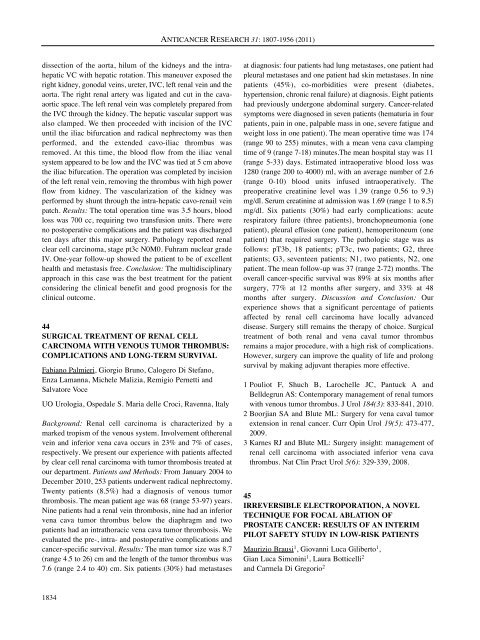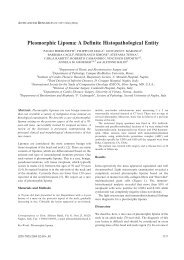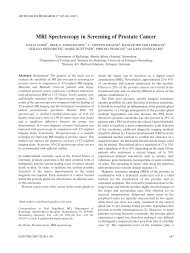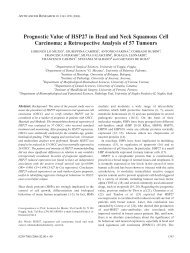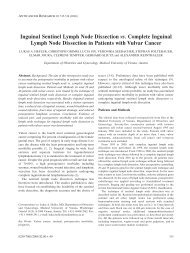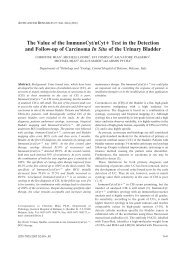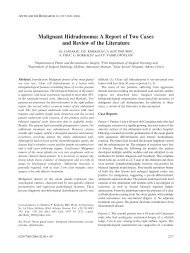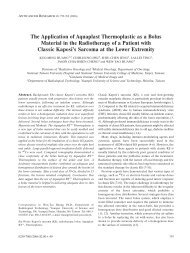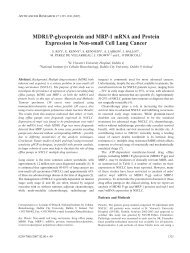ABSTRACTS OF THE 21st ANNUAL MEETING OF THE ITALIAN ...
ABSTRACTS OF THE 21st ANNUAL MEETING OF THE ITALIAN ...
ABSTRACTS OF THE 21st ANNUAL MEETING OF THE ITALIAN ...
Create successful ePaper yourself
Turn your PDF publications into a flip-book with our unique Google optimized e-Paper software.
dissection of the aorta, hilum of the kidneys and the intrahepatic<br />
VC with hepatic rotation. This maneuver exposed the<br />
right kidney, gonodal veins, ureter, IVC, left renal vein and the<br />
aorta. The right renal artery was ligated and cut in the cavaaortic<br />
space. The left renal vein was completely prepared from<br />
the IVC through the kidney. The hepatic vascular support was<br />
also clamped. We then proceeded with incision of the IVC<br />
until the iliac bifurcation and radical nephrectomy was then<br />
performed, and the extended cavo-iliac thrombus was<br />
removed. At this time, the blood flow from the iliac venal<br />
system appeared to be low and the IVC was tied at 5 cm above<br />
the iliac bifurcation. The operation was completed by incision<br />
of the left renal vein, removing the thrombus with high power<br />
flow from kidney. The vascularization of the kidney was<br />
performed by shunt through the intra-hepatic cavo-renail vein<br />
patch. Results: The total operation time was 3.5 hours, blood<br />
loss was 700 cc, requiring two transfusion units. There were<br />
no postoperative complications and the patient was discharged<br />
ten days after this major surgery. Pathology reported renal<br />
clear cell carcinoma, stage pt3c N0M0. Fuhram nuclear grade<br />
IV. One-year follow-up showed the patient to be of excellent<br />
health and metastasis free. Conclusion: The multidisciplinary<br />
approach in this case was the best treatment for the patient<br />
considering the clinical benefit and good prognosis for the<br />
clinical outcome.<br />
44<br />
SURGICAL TREATMENT <strong>OF</strong> RENAL CELL<br />
CARCINOMA WITH VENOUS TUMOR THROMBUS:<br />
COMPLICATIONS AND LONG-TERM SURVIVAL<br />
Fabiano Palmieri, Giorgio Bruno, Calogero Di Stefano,<br />
Enza Lamanna, Michele Malizia, Remigio Pernetti and<br />
Salvatore Voce<br />
UO Urologia, Ospedale S. Maria delle Croci, Ravenna, Italy<br />
Background: Renal cell carcinoma is characterized by a<br />
marked tropism of the venous system. Involvement oftherenal<br />
vein and inferior vena cava occurs in 23% and 7% of cases,<br />
respectively. We present our experience with patients affected<br />
by clear cell renal carcinoma with tumor thrombosis treated at<br />
our department. Patients and Methods: From January 2004 to<br />
December 2010, 253 patients underwent radical nephrectomy.<br />
Twenty patients (8.5%) had a diagnosis of venous tumor<br />
thrombosis. The mean patient age was 68 (range 53-97) years.<br />
Nine patients had a renal vein thrombosis, nine had an inferior<br />
vena cava tumor thrombus below the diaphragm and two<br />
patients had an intrathoracic vena cava tumor thrombosis. We<br />
evaluated the pre-, intra- and postoperative complications and<br />
cancer-specific survival. Results: The man tumor size was 8.7<br />
(range 4.5 to 26) cm and the length of the tumor thrombus was<br />
7.6 (range 2.4 to 40) cm. Six patients (30%) had metastases<br />
1834<br />
ANTICANCER RESEARCH 31: 1807-1956 (2011)<br />
at diagnosis: four patients had lung metastases, one patient had<br />
pleural metastases and one patient had skin metastases. In nine<br />
patients (45%), co-morbidities were present (diabetes,<br />
hypertension, chronic renal failure) at diagnosis. Eight patients<br />
had previously undergone abdominal surgery. Cancer-related<br />
symptoms were diagnosed in seven patients (hematuria in four<br />
patients, pain in one, palpable mass in one, severe fatigue and<br />
weight loss in one patient). The mean operative time was 174<br />
(range 90 to 255) minutes, with a mean vena cava clamping<br />
time of 9 (range 7-18) minutes.The mean hospital stay was 11<br />
(range 5-33) days. Estimated intraoperative blood loss was<br />
1280 (range 200 to 4000) ml, with an average number of 2.6<br />
(range 0-10) blood units infused intraoperatively. The<br />
preoperative creatinine level was 1.39 (range 0.56 to 9.3)<br />
mg/dl. Serum creatinine at admission was 1.69 (range 1 to 8.5)<br />
mg/dl. Six patients (30%) had early complications: acute<br />
respiratory failure (three patients), bronchopneumonia (one<br />
patient), pleural effusion (one patient), hemoperitoneum (one<br />
patient) that required surgery. The pathologic stage was as<br />
follows: pT3b, 18 patients; pT3c, two patients; G2, three<br />
patients; G3, seventeen patients; N1, two patients, N2, one<br />
patient. The mean follow-up was 37 (range 2-72) months. The<br />
overall cancer-specific survival was 89% at six months after<br />
surgery, 77% at 12 months after surgery, and 33% at 48<br />
months after surgery. Discussion and Conclusion: Our<br />
experience shows that a significant percentage of patients<br />
affected by renal cell carcinoma have locally advanced<br />
disease. Surgery still remains the therapy of choice. Surgical<br />
treatment of both renal and vena caval tumor thrombus<br />
remains a major procedure, with a high risk of complications.<br />
However, surgery can improve the quality of life and prolong<br />
survival by making adjuvant therapies more effective.<br />
1 Pouliot F, Shuch B, Larochelle JC, Pantuck A and<br />
Belldegrun AS: Contemporary management of renal tumors<br />
with venous tumor thrombus. J Urol 184(3): 833-841, 2010.<br />
2 Boorjian SA and Blute ML: Surgery for vena caval tumor<br />
extension in renal cancer. Curr Opin Urol 19(5): 473-477,<br />
2009.<br />
3 Karnes RJ and Blute ML: Surgery insight: management of<br />
renal cell carcinoma with associated inferior vena cava<br />
thrombus. Nat Clin Pract Urol 5(6): 329-339, 2008.<br />
45<br />
IRREVERSIBLE ELECTROPORATION, A NOVEL<br />
TECHNIQUE FOR FOCAL ABLATION <strong>OF</strong><br />
PROSTATE CANCER: RESULTS <strong>OF</strong> AN INTERIM<br />
PILOT SAFETY STUDY IN LOW-RISK PATIENTS<br />
Maurizio Brausi 1 , Giovanni Luca Giliberto 1 ,<br />
Gian Luca Simonini 1 , Laura Botticelli 2<br />
and Carmela Di Gregorio 2


